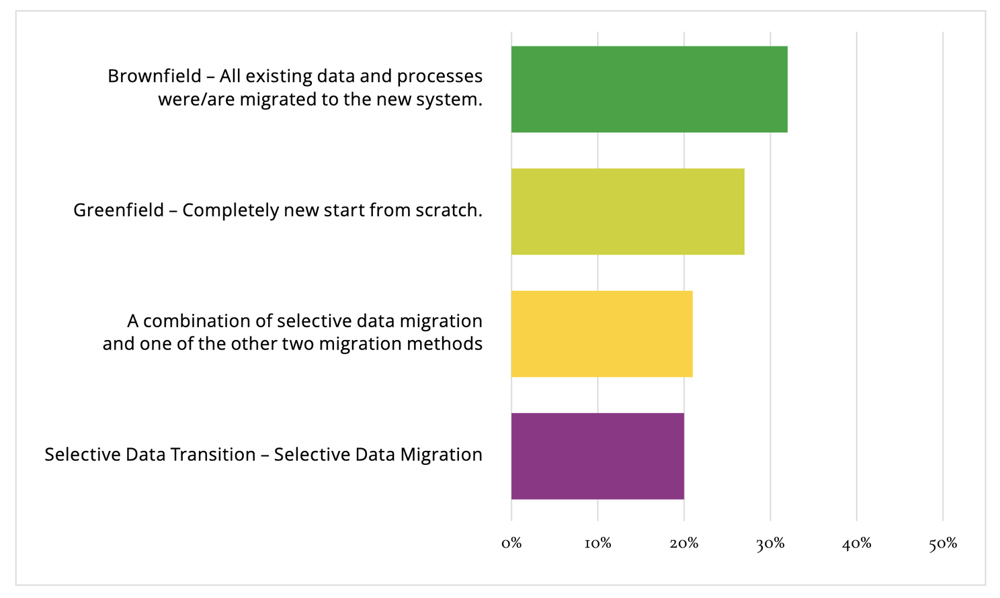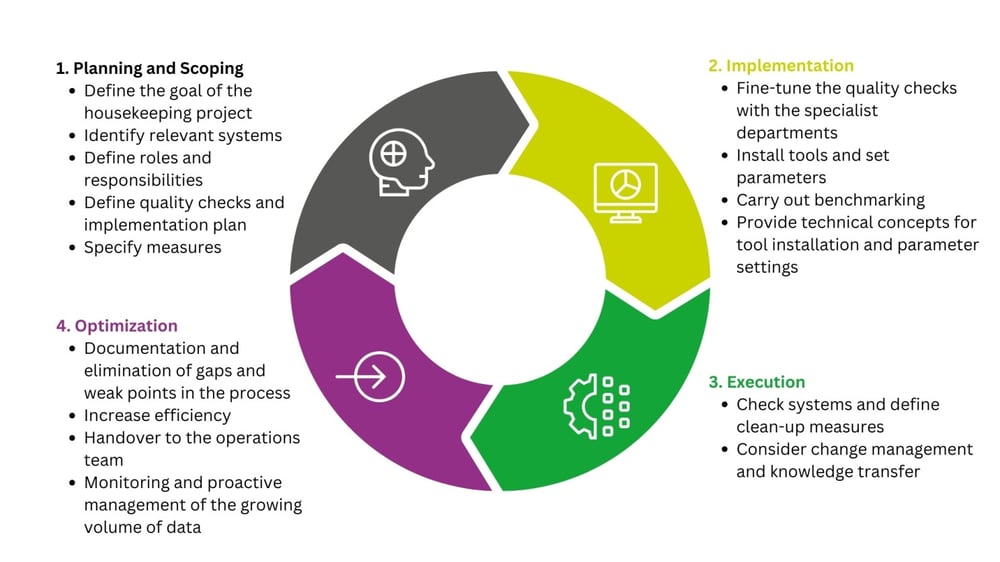How to deal with legacy systems and where to put the data
The situation is all too familiar: IT systems grow and thrive, and users become hunters and gatherers of data. Sooner or later, you inevitably must...

SAP customers are well aware of the necessity to complete their migration to SAP S/4HANA by 2027. As a result, many companies have already initiated their changeover plans. However, some are facing disillusionment, particularly those with extensive, long-established databases. Whether it's SAP, renowned consulting firms, or analysts, all recommend beginning the conversion process by cleansing the data. But the question remains, how? The answer lies in effective housekeeping! Philipp von der Brüggen, CMO of Natuvion GmbH, has curated valuable tips and tricks, outlining the optimal preparation for your transformation in four simple steps.
When people plan a move, they often create a checklist of items they wish to discard, donate, store, and bring along. Data housekeeping works the same way. Companies conduct an inventory to determine the quantity and nature of the data they possess within their systems. This data is meticulously examined for precision and consistency, cleansed, and restructured if necessary.
Housekeeping is provided as a cleanup procedure prior to a transformation project, which simplifies the process of transferring data to the new system. Consequently, you can segregate data that will be required in the future from outdated data. The benefit is that you commence your new system with a fresh start - namely, relevant, top-notch data and streamlined processes - while ensuring compliance with data protection regulations and other prerequisites. Additionally, the costs associated with storage are reduced due to a decrease in the volume of data to be migrated.
A crucial point to note: When conducting housekeeping before a transformation or migration project, it is essential to view it as an ongoing process rather than a one-time task. Instead, consider this as an opportunity to establish the foundation for consistently managing your Data Quality and Volume, even after transitioning to a new system. In this way, housekeeping becomes a vital component of your comprehensive Information Lifecycle Management (ILM) strategy.

Natuvion & NTT DATA Business Solutions Transformation Study 2023
Natuvion, in collaboration with NTT DATA Business Solutions, conducted a comprehensive survey with 630 top managers from nine different countries who have recently completed a relevant transformation. One of the survey questions focused on the transformation approach they had chosen: Brownfield - conversion of the entire system; Greenfield - complete reinstallation; or Selective DataTransition - combining the advantages of both approaches. The survey results indicated that the majority of companies, specifically 33%, opted for the Brownfield approach. It is important to note that for Brownfield projects, thorough Housekeeping before the actual migration is crucial for its successful implementation. Failing to do so may result in the transfer of inaccurate, outdated, and non-compliant data to the new environment without proper validation. Therefore, if you are considering the Brownfield migration approach, we highly recommend paying careful attention to this aspect.

Natuvion & NTT DATA Business Solutions Transformation Study 2023
When SAP talks about housekeeping, it typically means cleaning up the temporary SAP data that the system produces daily. This can include the following:
At Natuvion, we offer a holistic approach. When we refer to "housekeeping", we are referring to a comprehensive data analysis process across all your systems. Our goal is to identify any data quality issues, determine the data volume, reduce it, and ultimately enhance performance.
The criteria for Data Quality are:
The aim of Data Volume Management (DVM) is to keep the size of your data stocks under control. This in turn reduces the maintenance effort and costs for your storage systems, databases, and applications.
The most important DVM measures include:
Another crucial aspect of maintaining cleanliness and efficiently managing data is the removal of outdated information that is no longer necessary for you or your systems. The more data you accumulate, the more it impacts the performance of your applications. In SAP systems, a substantial amount of data is generated, which quickly loses its relevance and fails to contribute any added value to your company. To address this, SAP regularly provides a comprehensive guide on Data Volume Management. These tables solely consist of technical data, which can swiftly expand and encompass various elements, including but not limited to:
Determining the method and frequency of deleting unnecessary data is just as important as determining which data is "fresh" and active in your systems. In some areas, such as SAP BW, temporary data can make up between 20-40% of the system size.
As with any project, success or failure depends on effective planning in advance. Below you will find a suggestion for structuring your housekeeping project. In principle, the planning and scoping process will comprise the following decision steps:

An overview of the four phases of an efficient housekeeping project
DCS Analyze is a powerful solution that allows you to analyze all your data in the preparation phase of your DQM/DVM project. With over 500 analysis scenarios in eight different areas, this tool enables you to perform a holistic review and analysis of all your systems. DCS Analyze offers you the transparency you need in the following areas:
In housekeeping projects, DCS Analyze is ideal for gaining a detailed overview of the quality of master data (e.g. duplicates and inconsistencies), the volume of data, and the age of the data. It also provides information about the archiving status and how you can improve the data quality of non-archivable elements.
Prices, product specifications, contact information: master data forms the basis for important business decisions. However, manually maintaining and managing company-wide SAP master data is time-consuming and error-prone. Data quality and management can be improved through simplified and automated data maintenance. The solution: it.masterdata simplified (it.mds). it.mds was developed to automatically enrich and maintain your master data.
Many companies struggle with the definition of clear roles and responsibilities, as well as complex processes for their master data processes in SAP. The it.mds solution forms a solid governance structure and contributes to higher data quality by automating the underlying processes through AI-generated rules and guidelines. This leads to a reduction in manual errors, inconsistencies, and costs.
Once you have defined your chosen parameters, installed your analysis tools, and planned the project, it's time to get started. In the initial phase, your analysis tool will check the system(s) thoroughly. The result is a blueprint report of all the data in your system landscape. Based on these results, you and your data analysis and/or consulting team can create a meaningful roadmap for what to do next. This could include quality improvements, stricter data protection controls, or reducing data volumes - or all of these measures together if desired.
Information Lifecycle Management (ILM) is an indispensable tool for the proactive management of data volumes - especially in SAP environments. With a set of ILM rules tailored to your business needs, you can take action to prevent uncontrolled data growth and compliance violations. These rules automatically select data according to the criteria you define and then take appropriate action, such as blocking, archiving, or deleting. However, an efficient ILM goes even further: it forms the basis for all your data management activities following a housekeeping project. ILM can benefit your company not only in terms of managing data volumes and complying with regulations but also in terms of costs and system performance.
The final phase of your housekeeping project before and after the migration is to review the results of the analysis and determine where improvements can be made. This is initially about fine-tuning the housekeeping process itself, rather than making data corrections based on the analysis results, to ensure that the regular housekeeping you carry out at set intervals after your transformation project is complete is optimally aligned with your company's requirements. For example, you can easily identify whether data is missing or whether the workflow or process needs to be optimized to make it more efficient. You can also determine the effectiveness of the process itself.
Maintaining high data quality is complex and requires specialized knowledge and explicit resources within the company. However, this does not mean that all tasks related to ILM processes have to be performed manually. Rather, you can significantly reduce both the effort and the risk throughout the entire ILM process cycle by using powerful tools. DCS Analyze is one such tool. It is used both for the initial implementation of SAP ILM and during ongoing operations. DCS Analyze operational analyses were developed for the latter. On the one hand, these allow you to quickly and easily gain an overview of the current customizing of your ILM setup, the data to be locked and archived, and the legal cases or legal hold cases and to derive the optimal ILM project procedure from this. On the other hand, these analyses also allow you to better monitor ongoing ILM operations, including implemented rules and control areas as well as missing or incorrect settings. In addition, DCS Analyze allows you to fully automate the testing effort in advance of all ILM runs. This effort should not be underestimated either, because the ILM objects that make it possible to delete data in SAP ILM in the first place usually comprise large amounts of data.
So it's best to get started today!

The situation is all too familiar: IT systems grow and thrive, and users become hunters and gatherers of data. Sooner or later, you inevitably must...

In recent years, few topics have been discussed as intensely in the SAP industry press as the end of maintenance for SAP ERP 6. The industry press is...

Successful transformations require careful planning, accurate system insights, and a clear strategy. Companies should have a clear vision, choose the...